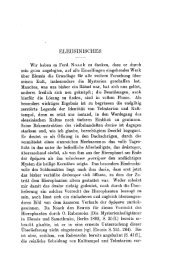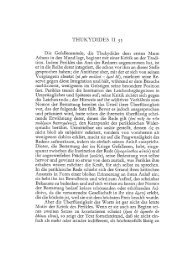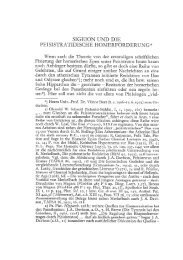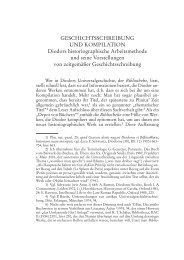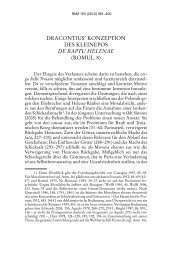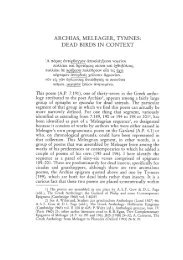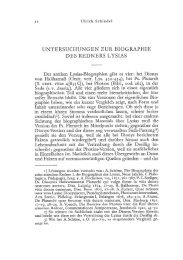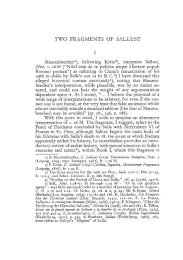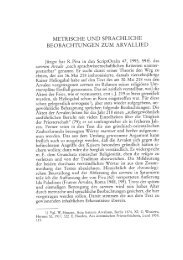APOTELESMATICA 2. (1) 14–140: SOURCES AND MODELS*
APOTELESMATICA 2. (1) 14–140: SOURCES AND MODELS*
APOTELESMATICA 2. (1) 14–140: SOURCES AND MODELS*
You also want an ePaper? Increase the reach of your titles
YUMPU automatically turns print PDFs into web optimized ePapers that Google loves.
76 Maria Ypsilanti<br />
the southern circle (ll. 101–4), Pseudo-Manetho includes only<br />
Centaur’s claws and the steering-oar of Argo, while Eudoxus included<br />
various other constellations (the River, Argo’s deck, the<br />
Beast, the Thymiaterion, the right legs of the Archer, Canopus, fr.<br />
74), accepted by Hipparchus katå suneggismÒn (1.11,7), except for<br />
Canopus. 13 The author’s utilisation of a globe, different from that<br />
of Hipparchus, is evident from the description of these constellations,<br />
as well as of those which follow.<br />
In his first account of the Meridian and the Horizon (ll. 43–<br />
9), Pseudo-Manetho emphasises the idea that the two circles are<br />
“between the poles”, and retain inwards the orbit of the stars (ll.<br />
48 f.). This emphasis probably aims to clarify that the circles are in<br />
fact in the sphere, and that they are conceived as being external<br />
only for the sake of comprehension by human mind, as commentators<br />
of Aratus remind the reader. 14<br />
The author of the Apotelesmatica calls the tropic of Cancer<br />
tropikÚw y°reow (l. 38, cf. 72) and the tropic of Capricorn xeimer¤oio<br />
trop∞w kÊklow (l. 40, cf. 93); here he follows Hipparchus who calls<br />
them ı yerinÚw tropikÒw and ı xeimerinÚw tropikÒw respectively,<br />
while Aratus does not use these terms, although he defines the<br />
tropics with reference to the north and south and the summer-winter<br />
solstices. 15 Aratus presents the tropic of Cancer in variation of<br />
Eudoxus’ account, beginning with the Twins and moving westward<br />
to end with the Crab (480–500), épÚ t«n §sxãtvn érjãmenow,<br />
as Hipparchus comments (1.2,18 f.), while Eudoxus begins with the<br />
Crab and is moving eastward to end again with the Crab. 16 Pseudo-Manetho<br />
retains this ‘proper order’ of Eudoxus.<br />
13) Hyginus is again not very far from Pseudo-Manetho, as he includes only<br />
the extreme part of Argo and Centaur’s feet, the Altar and the extreme trace of the<br />
River (4.6,3).<br />
14) Cf. Ach. 22 (p. 52 Maass) tÚn d¢ ır¤zonta ka‹ meshmbrinÚn §ntÚw e‰nai<br />
t∞w sfa¤raw t«n ˜lvn noht°on (oÈd¢n går t«n ˆntvn aÈt∞w §stin §ktÒw), Íp¢r d¢ toË<br />
parakolouy∞sai ≤mçw §ktÚw e‰nai l°gontai; cf. Anon. 1 (p. 95 Maass) ı d¢ ır¤zvn<br />
. . . ke›tai d¢ jv t∞w sfa¤raw …w prÚw tØn ≤met°ran ˆcin. tÚ dÉ élhy°w, t“ n“ aÈtÚn<br />
sv de› paralabe›n ke¤menon.<br />
15) Cf. ll. 499–500 y°reow d° ofl §n tropa¤ efisin. / ÉAllÉ ı m¢n §n bor°v per‹<br />
Kark¤non §stÆriktai, 507–9 tÚn pÊmaton kayaro›o parerxÒmenow bor°ao / §w nÒton<br />
±°liow f°retai, tr°peta¤ ge m¢n aÈtoË / xeim°riow.<br />
16) The Aratean order is also kept by Hyginus (4.2,1), Aratus Latinus VII<br />
(p. 277 ff. Maass).



